Land Return and Food Sovereignty on California's North Coast
And other end-of-summer Land Back news
Somehow we find ourselves in September. Starting last week, the local school bus resumed its regular stop on the corner near me, marking that hot weather or no, summer is by many measures officially over or at least on its way out. But before we head into the fall, let’s take a look at some of the Land Back news, action, and wins from these last few months.
Food and Indigenous Sovereignty on California’s North Coast
To kick us off, I’m excited to share that a feature piece I worked on last year is finally out in the world! I hope you’ll check out “Food and Indigenous Sovereignty on California’s North Coast” over at Mother Earth News. It will run in print editions later this year.
In it I take a look at the many innovative projects currently underway with the Wiyot Tribe through their Dishgamu Humboldt Community Land Trust (CLT). Not only is the Wiyot Tribe using its CLT to address a lack of housing and to restore access to traditional foods, it is finding a different way to structure the land trust itself, and to use the CLT as a vehicle for land return. Whereas most CLTs are run as non-profit entities, bound by the various restrictions placed on 501(c)(3)s, the Dishgamu Humboldt CLT is actually a “component unit” of the Wiyot Tribe itself, creating different possibilities for how the land can be held. If you are a resident on ancestral Wiyot territory, see their FAQ for info on how to return land to the tribe.
I visited several of the sites held by Dishgamu Humboldt in spring of 2023, including Mouralherwaqh, where the Wiyot Tribe is engaged in ecocultural restoration of forest and wetland, both maintaining habitat for culturally important plants and animals and preserving a corridor for wildlife migration to the coast. Photos and details over at Mother Earth: https://www.motherearthnews.com/real-food/food-indigenous-sovereignty-california-coast-zw0z2408zols/
More California Land Back News
Mouralherwaqh and the Wiyot Tribe’s other projects are all highlighted in a report newly updated this summer by Save California Salmon, on the state of the #LandBack movement in California. The report has a year-by-year breakdown of land return projects—there were 5 just in the first half of 2024—and looks into how rematriation has become part of California’s strategy for addressing climate change. It also has a special section focused on “Surplus Lands.”
We mentioned this concept of ‘surplus’ or ‘excess’ land in our post back in June on the return of the Mt. Whitney Fish Hatchery to the Fort Independence Indian Community (see “A Surprise in the Eastern Sierra”). I expressed skepticism there about this, wondering if this was just state officials looking to offload unprofitable properties rather than aiming to restore culturally significant sites. But, according to the authors of this report, utilizing the surplus land designation to allow for transferring parcels from local to tribal governments was actually an innovation of tribes, challenging a long history in which guidelines on surplus lands had typically been used to remove land from tribal governance. This changed in 2022, when the City of Eureka used the surplus land classification to be able to return Tuluwat Island to the Wiyot Tribe, setting precedent for other local governments to do the same.
The return of Tuluwat was a tremendous moment for the Wiyot, but the ‘surplus land’ designation has also created additional difficulties, requiring the tribe to clear a labyrinth of bureaucratic hurdles and shifting the expensive burden for remediation onto them. To learn more about the complications with the return of Tuluwat and the use of surplus lands for land return more generally, see pages 25-30 of the report.
Of course, the biggest news coming out of the Golden State this summer isn’t about a single parcel of land, but about a moving body of water: just last week, the final dams were breached on the Klamath River, allowing the free passage of salmon for the first time in over a century.

Check out OPB’s coverage of this landmark moment, and our earlier post on the Klamath, “History in the Making.”
It’s Not Just California
We can be a little West Coast-centric here, given my own location, but that shouldn’t make you believe that Land Back efforts aren’t happening all over the country. Here are just a few of the other headlines from recent months:
The Keweenaw Bay Indian Community (KBIC) of the Lake Superior Band of Chippewa Indians received back over 700 acres through collaboration with The Nature Conservancy in Michigan.
The Winnebago Tribe in Nebraska had 1600 acres of land illegally taken by the U.S. Army Corps of Engineers returned to them after successful passage of the Winnebago Land Transfer Act.
The Mille Lacs Band of Ojibwe had 18 acres returned by the state of Minnesota. The Mille Lacs bill was just one of several Land Back bills introduced this year in the Minnesota legislature, though it was the only one to pass. But the University of Minnesota has been explicit in its intent to continue to press for restoration of 3400 acres to the Fond du Lac band of Lake Superior Ojibwe, and has made it easy to read about the history of the University’s decision and approach to return the land currently used for the Cloquet Forestry Center.
And while we’re correcting our geographic blinders, let’s note that Land Back is not just a North American phenomenon. This summer also saw the Knasaimos Indigenous Community of Southwest Papua, in Indonesia, receive formal recognition of their rights to over 240,000 acres.
That’s the end of our little news catch-up on this long weekend. Know any stories I missed that are worth sharing with everyone here? Leave them in the comments or send them to unsettling@substack.com.
Thanks for reading. Until next time,
Meg





